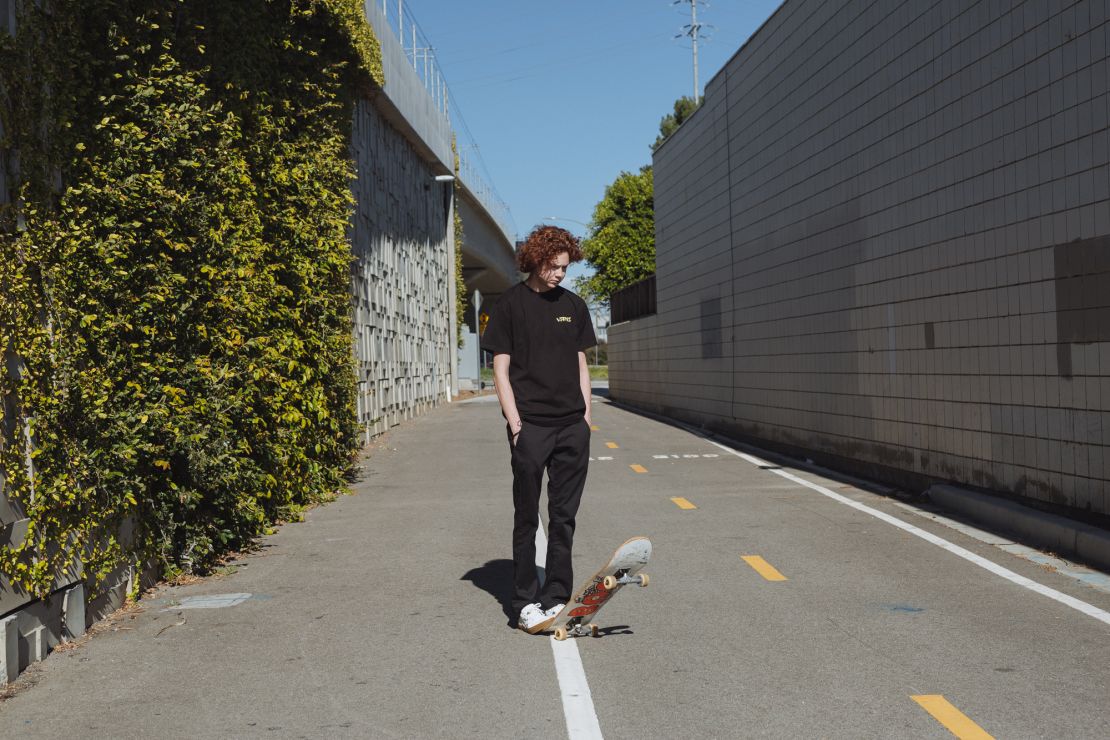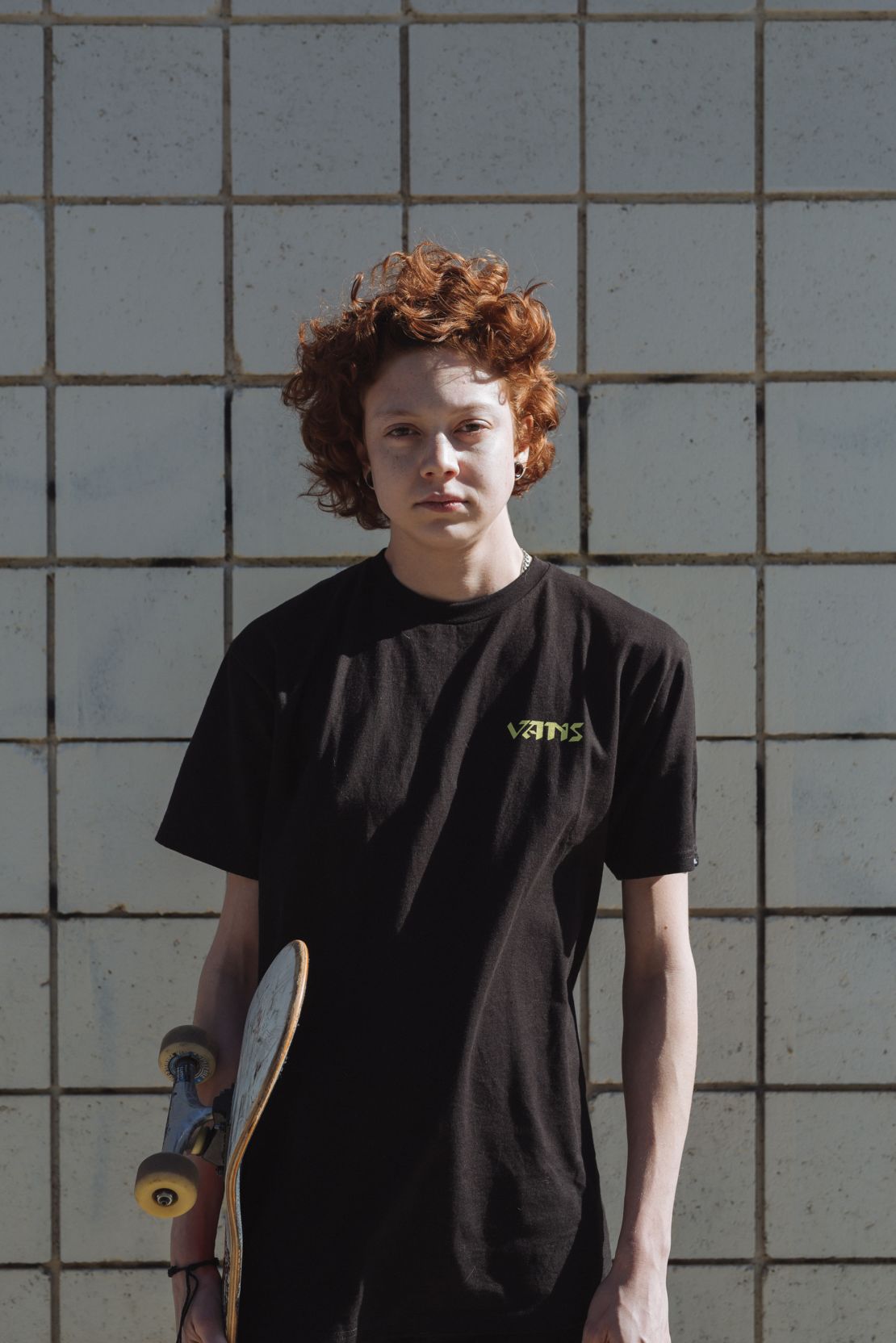When I ask Nathan Westling what he sees in the mirror, he describes “a masculine version of my old self.” His red hair is shorn short, his voice has deepened and his face seems more angular, despite the fact he’s about 20 pounds heavier than he was six months ago. (“But it looks good,” the 22-year-old insists, laughing. “I’m growing into my young adult male body.”)
He hasn’t sprouted any facial hair, to his mild disappointment, but otherwise Westling looks like just another Santa Monica skater boy – albeit one with an otherworldly beauty about him.
Until recently, it seemed like you couldn’t open a major fashion magazine without seeing Westling’s dark eyes staring out at you from behind his signature cascading curls. Since making his high fashion debut on the Marc Jacobs runway in 2013, when he was still going by the name Natalie, Westling had ascended to the upper ranks of the industry, fronting ad campaigns for the likes of Louis Vuitton, Versace, Prada, Chanel, Dior and Alexander McQueen, and appearing in Vogue’s American, Chinese, Japanese, Italian, French and Russian editions.
But by last April, his priorities had shifted from his career to himself. After a decade spent receiving therapy and medication for depression, anxiety and anger issues, he finally decided to address what he’d always known to be the underlying problem. To do so, he decamped from his base in New York to Los Angeles to begin transitioning from life as Natalie to life as Nathan.
“I hit a point where I was tired of just existing, because that was kind of my whole life and how I lived. I always questioned how people just lived life, and just woke up and felt good and could just do things. And I couldn’t,” Westling says on the phone from his apartment in LA.

“It wasn’t all sunshine and rainbows in the beginning. My first two months of the transition were tough, and it wasn’t until I started to see physical changes that aligned with … my mental state that I finally woke up and (started) living. I’m happy. I can’t even imagine going back to how I was before because it’s just darkness.”
It’s been six months since Westling began taking testosterone. He’s upbeat and optimistic, unguardedly sharing details about his plans to get top surgery to reconstruct his chest, his plans to move back to New York, his plans to finally connect with the transgender community, his plans to return to fashion. (He hasn’t taken on new work since walking at Paris Fashion Week last October.)
He’s also candid about growing up in Scottsdale, Arizona, where “they look at the (transgender) people like me – or any gay, lesbian people, anybody in the LGBT scene – as freaks because they’re just ignorant, they’re not educated.” At his 3,000-plus-student high school, Westling remembers meeting only one openly gay student, and feeling he had no one with whom to safely discuss his gender dysphoria. But those feelings, he says, went back much further than high school.
“I (have) this vivid memory of me being on the playground in preschool, talking to the girls and feeling completely out of place and not fitting into what they were thinking about, talking about, how their body language was or anything like that, and then having the same conversation with one of my guy friends and it completely clicking,” he recalls. “That was the initial thing (that sparked my questions about gender), but as time progressed and we got older, it was even more apparent when puberty hit.”

When Westling was 16, his mother pushed him into modeling, set on seeing her child – who fit the young, tall, thin ideal – realize her own deferred dream. Though he initially fought it (“I live on my skateboard, I’m so the opposite. No!”), Westling credits his experiences in the fashion world with helping him come to terms with his own trans identity.
“Working as a model, you know, a lot of people ask, ‘Did that screw with you? Did that hurt you?’” he says. “(Modeling) was cool to me because I’ve always been playing a character, a persona, my whole life. So to be able to be put in all this different hair and makeup, I was able to discover myself as well, and see myself as so many different things; to really know that this is who I should be and the path I should take.”
Trans models have long had a presence in fashion. David Bailey shot British model April Ashley for Vogue in the ’60s, and African-American model Tracey Norman graced the pages of Vogue Italia in 1971 after charming Irving Penn. But both models’ careers were cut short when they were outed as trans.
“Beauty and fashion is all about illusion,” Norman, now 67, told New York magazine fashion blog The Cut in 2015. “So when the doors were opened for me, I walked right through. And then the doors slammed … Once the doors closed, I was no longer a woman and I no longer got the respect of a woman. People who used to say ‘she’ now said ‘he,’ and it’s not who I am and it’s not the person that I identify with. It’s like you, as a person, no longer exist.”

It’s only in the last decade that trans models have been able to achieve high-fashion success without concealing their trans identity. In 2010, Brazilian model Lea T became the first out trans woman to appear in a high fashion campaign when she became a face for the house of Givenchy; and five years later, Bosnian-Australian model Andreja Peji?, who made her name as Jean Paul Gaultier’s androgynous male muse in 2011, became the first trans model to be profiled in Vogue. Momentum has only increased since then, and, in recent seasons, out trans models like Teddy Quinlivan, Hunter Schafer, Hari Nef and Dara have walked the runway and appeared in campaigns for some of the world’s most recognizable brands.
However, out trans male models remain rare in fashion, and when Westling returns to the industry, he’ll instantly become the most high-profile trans man working at the top tier. He and his agents have already been in touch with past major clients, and he says the responses have been universally supportive. A week before our interview, Westling was shot for the cover of a major fashion magazine (no, he won’t tell me which one), and while he declines going into detail, he says the designers he’s worked closest with have promised to stand by him.

But beyond this magazine shoot, Westling isn’t sure where his career will take him next. “We’ll have to see how this story takes to fashion and how everything takes,” he says. “I’m not worried about it. I think it’s going to be a good change and I’m excited for it. I’m really, really excited.”
For now, he’s just enjoying the simple pleasure of being called “sir” and being referred to by his correct pronouns, and cherishing the support of his friends and family.
“It feels like I’ve been wearing like a mask my whole life,” he says. “Once I removed that mask, it was like I was finally… I don’t know. I’m not wearing a skin that I don’t feel I am anymore. I’m not playing a persona; I’m not trying to be something I’m not anymore. I don’t feel like I’m stuck in this weird moment of having to be in-between.
“It’s been an incredible journey, it’s been an incredible process and I’m just really happy to be on this path – and at such a young age, too. That’s such a blessing.”
